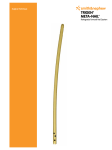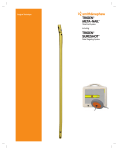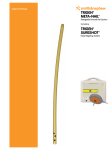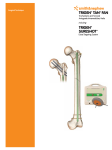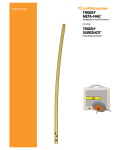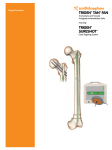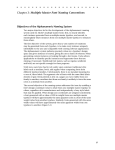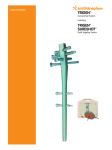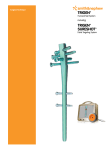Download TRIGEN META-NAIL Semi-extended Instrument Set
Transcript
Surgical Technique Table of contents Introduction............................................................................. 3 TRIGEN™ META-NAIL™ Tibial Nail Specifications....................... 4 Surgical Technique.................................................................. 5 Patient positioning......................................................................... 5 Prepare the Entry Tube.................................................................. 5 Incision and entry point: Lateral subluxation of the patella........... 6 Entry portal acquisition....................................................................7 Entry portal .....................................................................................7 Alternative technique: Entry portal................................................. 8 Reduce the fracture........................................................................ 9 Determine the implant length....................................................... 10 Unreamed technique.....................................................................11 Reamed technique.........................................................................11 Nail assembly................................................................................ 12 Nail insertion................................................................................. 13 Check nail depth........................................................................... 14 Lock the screw.............................................................................. 15 Proximal locking............................................................................ 16 Proximal locking: Compression.................................................... 17 Nail extraction: optional................................................................ 18 An alternative method for extraction ........................................... 19 Catalog information............................................................... 20 Nota Bene The technique description herein is made available to the healthcare professional to illustrate the authors’ suggested treatment for the uncomplicated procedure. In the final analysis, the preferred treatment is that which addresses the needs of the patient. The technique is based on the tibial nailing approach outlined in the article below: Tornetta P, 3rd, Collins E. Semiextended position of intramedullary nailing of the proximal tibia. Clin Orthop Relat Res. 1996: Number 328, pp 185-189. Introduction The following technique is for informational and educational purposes only. It is not intended to serve as medical advice. It is the responsibility of treating physicians to determine and utilize the appropriate products and techniques, according to their own clinical judgement, for each of their patients. For more information on the TRIGEN™ META-NAIL™ Tibial Nail System, including its indications for use, contraindications, and product safety information, please refer to the product’s label, the Instructions for Use (REF 81068703) packaged with the product, and, if using the TRIGEN SURESHOT™ Distal Targeting System, the TRIGEN SURESHOT Distal Targeting System User Manual (REF 7118-1540). The TRIGEN META-NAIL Tibial Nail System is designed specifically to repair fractures of the proximal and distal thirds of the tibia, including the shaft, stable and unstable fractures, nonunions, malunions, and for the prophylactic nailing of impending pathological fractures. The META-NAIL System can be used with or without the SURESHOT Distal Targeting System. If using the SURESHOT Distal Targeting System, be sure to read and understand the TRIGEN SURESHOT Distal Targeting System User Manual (REF 7118-1540). Only trained operators are allowed to use the TRIGEN SURESHOT Distal Targeting System. 3 TRIGEN™ META-NAIL™ Tibial Nail Specifications 10º 10mm 23mm 40mm 27mm Distal end of nail (all knee and distal tibial) 17mm Specifications TRIGEN META-NAIL Tibia (8.5mm) TRIGEN META-NAIL Tibia Material Ti6Al4V Ti6Al4V Diameter 8.5mm 10, 11.5 & 13mm Lengths 16-50cm* 16-50cm* Nail Color Grey Gold Cross Section Round Round Proximal Diameter (driving end) 12mm 12mm (10, 11.5 diameter) 13mm (13 diameter) Distal Diameter (non-driving end) 8.5mm 10, 11.5 and 13mm Smallest Through Diameter 4.8mm 5.0mm Wall Thickness 1.9mm 2.3mm (10) 3.0mm (11.5) 2.3mm (13) Guide Bolt Thread 5/16-24 UNF 5/16-24 UNF Screw Diameter 4.5mm 5.0mm Screw Color Grey Gold Major Diameter 4.5mm 5.0mm Minor Diameter (core) 4.0mm 4.3mm Screw Lengths 25-65mm 25-110mm Hex Size 4.7mm 4.7mm Alternative Hexdrivers RT Femoral & Recon 7.0mm Cannulated Screw PERI-LOC™ Locking Screw RT Femoral & Recon 7.0mm Cannulated Screw PERI-LOC 4.7mm Hexdriver PROFIX™ 4.7mm Hexdriver Alternative Modes No No 30mm Top view of nail Proximal Locking (Driving End) 60mm 2º ML view Figure 1 Non-driving end of nail (AP view) Static Lock Locations/Orientations 17mm/45° Screw Locked w/META-NAIL Cap 23mm/45° Threaded w/bushing 30mm/25° Threaded 40mm/25° Threaded Static Locking Hole Dimensions Threaded 4.3mm minor diameter Threaded 4.7mm major diameter Threaded 4.5mm minor diameter Threaded 5.3mm major diameter Compression/Dynamic Slot Location 10mm 10mm Compression/Dynamic Slot Diameter/Length 4.7mm/7mm 5.3mm/7mm Degree of Proximal Bend 10° (Herzog) 10° Proximal Bend Location 27mm 27mm Distal Locking (Non-Driving End) Static Lock Locations/ Orientations 25mm/ML 15mm/AP 5mm/ML (Threaded) 25mm/ML 15mm/AP 5mm/ML (Threaded) Static Locking Hole Dimensions 4.7mm** 5.3mm** Degree of Distal Bend 2° 2° Distal Bend Location 60mm 60mm Note: These views are not to scale and should *Set does not include all sizes. **Most distal hole threaded. be used as a pictorial representation only. 4 Surgical Technique Patient positioning Position the patient supine on a radiolucent table with the unaffected limb extended away from the affected limb. For the semi-extended technique, the operative limb should be in 10–20° of flexion. Caution: If using the TRIGEN™ SURESHOT™ Distal Targeting System, verify that there are no metal objects in the immediate targeting area. Metal interference will cause the SURESHOT System to Figure 2 be inaccurate. Prepare the Entry Tube 1. Inspect the Entry Tube to ensure that it is not damaged, bent or chipped. Any flaws in the tube can lead to damage of the surrounding tendons and tissues. Entry Tube Guide Pin Sleeve 2. Assemble the Entry Tube (7165-4526) to the Entry Portal Handle (7167-4092) by pulling back the black trigger of the Entry Portal Handle and inserting the Entry Tube into the handle ring. 3. Turn the tube until it clicks into a Figure 3 Entry Portal Handle locked position. 4. Place the Guide Pin Sleeve (7165-4527) through the tube until it locks into both the end of the sleeve and Entry Portal Handle ring. Optional: Suction can be applied to the Entry Portal Handle. 5 Incision and entry point: Lateral subluxation of the patella 1. Make a midline skin incision approximately 1.5 inches in length from the upper pole of the patella to the middle of the patella (Figure 4). Make a second deep incision medial to the patella, cutting the superior two-thirds of the medial retinaculum, but leaving the cuff intact. 2. Extend the incision 1–2cm into the quadriceps tendon (Figure 5). This incision is through the medial one-third of the quadriceps tendon as outlined in the image. 3. Sublux the patella laterally and pass the fully assembled entry tube through the skin incision until it is sitting on the tibial plateau (Figure 6). Figure 5 6 Figure 4 Figure 6 Entry portal acquisition 1. Use the femoral condyles as guides for proper tube placement, making sure that the Guide Pin Sleeve sits at the appropriate entry point (Figure 7). 2. Locate the entry point just medial to the lateral tibial eminence in the AP view, and in line with the anterior cortex and intramedullary canal in the lateral view (Figure 8). 3. Attach the 3.2mm Brad Point Guide Pin (7167-4130 or 7163-1436) to the drill via the Mini Connector (7163-1186) and insert the guide pin into the Guide Pin Sleeve (Figure 9). Note: If the guide pin insertion is suboptimal, insert the Semi-extended Honeycomb (7165-4533) and rotate the Honeycomb within the Entry Tube to the desired location. Insert another 3.2mm Brad Point Guide Pin. Avoid over-insertion of the guide pin as this can establish a false trajectory and subsequently cause fracture malalignment. AP Figure 7 Lateral Figure 8 Figure 9 Entry portal 1. After guide pin placement, remove the Guide Pin Sleeve and carefully slide the Entry Tube down and onto the tibial plateau (Figure 10). 2. Attach the 12.5mm Entry Reamer (7163-1116) to a power drill. Advance the reamer over the guide pin and through the Entry Tube into the tibia to a depth of 4–6cm. Maintain alignment to avoid penetration of the posterior cortex. 3. Check position of the entry reamer via radiographic imaging and then remove the Entry Reamer and Guide Pin. Figure 10 7 Alternative technique: Entry portal 1. With the Entry Tube (Figure 11) and Entry Portal Handle (Figure 12) still in the joint space, attach the T-handle (7167-4076 or 7167-4576) (Figure 13) to the Cannulated Awl (Figure 14). Note: Introduce the 3.2mm T-handle Trocar (7167-4074) (Figure 15) into the back of the assembly prior to insertion in order to prevent awl slippage and the accumulation of cortical bone within the cannulation. 2. Insert the awl into the proximal tibia to a depth of 4–6cm. T-handle Cat. No. 7167-4076 or 7167-4576 Figure 13 Cannulated Awl Cat. No. 7167-4000 Figure 14 3.2mm T-handle Trocar Cat. No. 7167-4074 Figure 15 8 Entry Tube Cat. No. 7165-4526 Figure 11 Entry Portal Handle Cat. No. 7167-4092 Figure 12 Reduce the Fracture 1. Open the Gripper (7167-4080). 2. Insert the smooth back end of the 3.0mm Ball Tip Guide (7163-1626) into the front of the Gripper and gently close the trigger grip (Figure 16). Trigger grip 3. Connect the Reducer and Reducer Connector (7167-4077) so that the words “Slot Orientation” are in line with the opening at the Reducer’s tip (Figure 17). Figure 16 Reducer Reducer Connector Figure 17 4. Connect the assembly to the T-handle. 5. Advance the Reducer through the Entry Tube into the intramedullary canal and use the curved tip to direct the 3.0mm Ball Tip Guide Rod past the fracture into the region of the distal epiphyseal scar (Figure 18). Note: The guide rod should be center-center in the AP and lateral views. Figure 18 Reduce removal 1. Once the guide rod reaches the desired depth, detach the Gripper and remove the Reducer from the tibial canal. 2. To maintain guide rod position within the canal, slide the Obturator (7167-4078) into the back of the T-handle during extraction (Figure 19). Figure 19 9 Determine the implant length 1. Confirm that the Ruler opens easily. If it does not, adjust the thumb-wheel connection at the end to ensure free movement. 2. After the Reducer has been removed, reconfirm the guide rod placement within the distal tibia. 3. Slide the Ruler (7167-4079) over the guide rod until the metal tip contacts the proximal tibia (Figure 20). 4. Confirm the guide rod position in the window at the opposite end of the Ruler as shown in order to ensure accurate implant measurement (Figure 21). 5. Push down on the top of the Ruler until it Figure 20 contacts the 3.0mm Ball Tip Guide Rod. Note: Ensure that the ruler is in contact with the Ball Tip Guide Rod. Window 6. Read the implant length from the exposed calibrations at the end of the Ruler. 7. Confirm fracture reduction to ensure that the implant length is not underestimated. Reference the fibula for accurate fracture distraction or compression. Thumb wheel Figure 21 10 Unreamed technique 1. Use radiographic templating to determine nail size (Figure 22). Note: The appropriate-diameter implant provides translational fill within the isthmus of the intramedullary canal. 2. To help avoid implant incarceration during insertion, select a nail approximately 1.0–1.5mm less than the narrowest canal measurement on the lateral radiograph. Note: The 8.2mm diameter of the Reducer provides an initial determination of the canal width in small-diameter tibias. Reamed technique 1. Use radiographic templating to determine nail size. Figure 22: TRIGEN™ META-NAIL™ Tibial Nail Radiographic Template, Cat. No. 7118-0810 2. Use the 9.0mm Front Cutting Reamer Head (7111-8231) and Flexible Reamer Shaft (7111-8200) to ream the intramedullary canal sequentially in half-millimeter increments to a size 1.0–1.5mm larger than the selected nail size (Figure 23). 3. To ensure Guide Rod placement during reaming, insert the Obturator (7167-4078) into the back of the Reamer unit during retraction. 4. Continue to confirm Guide Rod placement in the distal tibia throughout reaming. Note: Periodically move the reamer back and forth in the canal to clear debris from the cutting flutes. Figure 23 11 Nail assembly 1. Use the Semi-extended Guide Bolt (7165-4525) to attach the META-NAIL™ Semi-extended Drill Guide (7165-4524) to the nail. Guide Bolt 2. Tighten with the Guide Bolt Wrench (7163-1140) and T-handle. The nail is correctly aligned when: META-Nail Semi-extended Drill Guide }} The vertical black line on the posterior side of the insertion barrel aligns with the line on the posterior side of the nail. }} The “A” on the anterior side of the nail aligns with the “A” on the anterior side of the insertion barrel (Figure 24). }} The apex of the nail’s proximal Herzog Bend faces posteriorly and the drill guide is oriented anteriorly (Figure 25). Note: The bevel on the front of the nail marks the connection to the drill guide and can be seen in the lateral view as a means to determine proximal insertion depth. TRIGEN™ META-NAIL Figure 24 3. Attach the META-NAIL Anterior Drop (7165-4501) to the drill guide. To verify the accuracy of the target, insert a gold 9.0mm Drill Sleeve (7163-1152) and silver 4.0mm Drill Sleeve (7167-4083) into the drop (Figure 26), and then pass a 4.0mm Long Pilot Drill (7163-1110) through the assembly. Note: An incorrectly attached nail will not target. Note: If using the SURESHOT™ Distal Targeting System, refer to the TRIGEN™ SURESHOT Distal Targeting System’s User Manual (REF 7118-1540) for the field accuracy check instructions. Figure 25 META-NAIL Anterior Drop 9.0mm Drill Sleeve Figure 26 12 Nail insertion Remove the Entry Tube and Handle 1. Remove the Anterior Drop and attach the Cannulated Impactor-Medium (7167-5081) to the drill guide. 2. Orient the drill guide assembly in the AP (anteroposterior) position. 3. Use light blows with the Slotted Hammer (7167-4082) to advance the nail over the guide rod. Note: If excessive force is required to insert the nail, additional reaming of the intramedullary canal may be required. 4. Verify fracture reduction as the nail crosses Figure 27 the fracture site by paying close attention to rotation, length, alignment, distraction and/or shortening of the affected limb. 5. Check the final nail position in both the AP and lateral views to confirm correct alignment. Note: To obtain provisional fixation of the proximal tibial fragments, reattach the Anterior Drop and insert the gold 9.0mm Drill Sleeve (7163-1152) and silver 4.0mm Drill Sleeve (7167-4083) into one of the two Blocking Screw holes in the Drop, then pass a 4.0mm Long Pilot Drill (7163-1110)* through the drill sleeves. *The 4.0mm Long Pilot Drill (7163-1110) is interchangeable with 4.0mm AO Long Drill (7163-1121) 13 Check nail depth Check the proximal nail depth In the lateral view, confirm nail position by observing the nail/drill guide junction (Figure 28). Note: If compression or dynamic locking is desired, countersink the nail approximately 10mm in order to avoid implant prominence. Check the distal nail depth 1. In the AP and lateral views, confirm that the nail has been inserted to the desired depth (Figure 29). Figure 28 Note: Optimal insertion depth, which will allow room for screw insertion below the fracture, is essential. Distal third tibial fractures require at least two locking screws to maintain stability. 2. Remove the Guide Rod once the nail is fully seated. 3. Reattach the Anterior Drop. 4. Following nail insertion, confirm that the nail and drill guide are securely connected. Hammering can loosen the Guide Bolt. Figure 29 14 Lock the screw Determine the length of the locking screw A There are three options available to determine the locking screw lengths: •• Gold 9.0mm Drill Sleeve, silver 4.0mm Drill Sleeve and 4.0mm Long Pilot Drill* (Figure 30A). •• Screw Depth Gauge (7163-1189) (Figure 30B). •• Screw Length Sleeve (7167-4085) and 4.0mm Short Drill (7163-1117)** (Figure 30C). Note: For information regarding Drill Depth Measurement Software (DDM) using the TRIGEN™ SURESHOT™ Targeting System, refer to the TRIGEN SURESHOT Targeting System User Manual (7118-1540). The DDM software can be used for distal locking only. C B Figure 30 Insert the Locking Screws Proximal locking options include three statically locked threaded holes and one slot that allows for both fracture compression and/or dynamization. These are targeted through the orange and blue color-coded holes on the Anterior Drop. Distal locking options include three statically locked holes: two ML (mediolateral) and one AP. The most distal ML hole is threaded for additional stability. Gold 5.0mm locking screws are compatible with 10mm, 11.5mm and 13mm diameter nails. Grey 4.5mm locking screws are compatible with 8.5mm diameter nails. Note: Do not use the 4.0mm Short Step Drill (7164-1123) when drilling for a grey 4.5mm locking screw. Its diameter transitions from 4.0mm to 4.7mm and will drill too large a hole in the near cortex, which may compromise locking screw purchase. Note: If using the SURESHOT Distal Targeting System, be sure to remove the probe prior to proximal locking. Figure 31: META-NAIL™ Tibial Nail with all four proximal screws inserted *The 4.0mm Long Pilot Drill (7163-1110) is interchangeable with 4.0mm AO Long Drill (7163-1121) **The 4.0mm Short Drill (7163-1117) is interchangeable with 4.0mm AO Short Drill (7163-1123) 15 Proximal locking Static locking 1. Make a small incision at the site of screw entry. 2. Insert the gold 9.0mm Drill Sleeve and silver 4.0mm Drill Sleeve through the static slot (STAT) on the Anterior Drop (Figure 32) down to bone. 3. Drill both cortices with the 4.0mm Long Pilot Drill*. 4. Measure for screw length using either the calibrations on the 4.0mm Long Pilot Drill* or by removing the 4.0mm Drill Sleeve and using the Screw Depth Gauge. Figure 32 5. Attach the appropriate-length screw to the end of the Medium Hexdriver (7163-1066). 6. Use power to insert the screw through the gold 9.0mm Drill Sleeve until the laser-etched ring on the Hexdriver reaches the back of the Drill Sleeve. 7. Attach the T-handle to the Hexdriver and tighten the screw by hand. Dynamic locking 1. With the nail countersunk approximately 10mm, make a small incision at the site of screw entry and insert the gold 9.0mm Drill Sleeve and silver 4.0mm Drill Sleeve through the dynamic slot (DYN) on the Anterior Drop down to bone (Figures 33 and 34). 2. Drill both cortices with the 4.0mm Long Figure 33 Pilot Drill*. 3. Use the techniques described in the “Lock the Screw” section to measure and insert the screw. Note: Use the “TIBIA” and “ALL NAILS” holes marked on the META-NAIL™ Anterior Drop. Note: If the screw is left in the dynamic mode, a nail cap cannot be used as it will push against the locking screw. Figure 34 *The 4.0mm Long Pilot Drill (7163-1110) is interchangeable with 4.0mm AO Long Drill (7163-1121) 16 Proximal locking: Compression There are two methods that can be used to compress the fracture: Compression Driver method 1. Countersink the nail a minimum of 10mm (Figure 35). 2. Lock the nail distally. 3. Reduce the fracture as much as possible to maximize the advantage of the compression driver. 4. Insert a screw through the proximal side of dynamic slot as described in the “Dynamic locking” section. 5. Remove the gold 9.0mm Drill Sleeve and Medium Hexdriver. Figure 35 6. Attach the Universal Compression Driver (7165-4528) to the T-handle and thread it through the guide bolt into the top of the nail until it contacts the most proximal 5.0mm locking screw (Figure 36). 7. Turn the Compression Driver clockwise to advance the driver and drive the locking screw distally, which will compress the fracture up to 7mm (Figure 37). Note: If there are screws in the other proximal holes, the fracture cannot be compressed. Note: Use fluoroscopy to check dynamic screw position when compressing the fracture. 8. Once the fracture gap is adequately compressed, lock the nail with up to three additional proximal static screws while the Anterior Drop is still attached to the drill guide. Figure 36 Note: If the Compression Driver is progressed after the fracture is fully compressed, the locking screw will begin to bend. In extreme cases where excess force is applied, the screw may break upon removal. Figure 37 17 Nail Cap Set Screw method 1. Lock the nail distally, then fully insert the dynamic locking screw as previously described. 2. Remove the Drill Guide/Anterior Drop assembly. 3. Insert the Nail Cap Set Screw (7165-6000) into the top of the nail and advance with the Medium Hexdriver/T-handle assembly until the fracture is compressed and the Nail Cap Set Screw has fully engaged the locking screw (Figures 38a and 38b). Note: If there are screws in the other proximal holes, the fracture cannot be compressed. Note: Use fluoroscopy to check dynamic screw position when compressing the fracture. Figure 38a Note: For information on the use of Blocking Screws, refer to the TRIGEN™ META-NAIL™ Tibial Nail Surgical Technique (7118-1610). Nail extraction: optional Standard technique 1. If implanted, remove the Nail Cap or Nail Cap Set Screw by using the Medium Hexdriver/T-Handle assembly. 2. Remove all the distal locking screws, and all but one of the proximal locking screws. 3. Thread the Cannulated Impactor-Medium (7167-5081) or Cannulated Impactor-Long (7163-1185)* into the back of the Disposable Nail Extractor (7163-1320)**. 4. Thread the assembly into the top of the nail. 5. Remove the remaining proximal locking screw. 6. Use the Slotted Hammer with a back-slapping motion to extract the nail (Figure 39). Figure 39 *The Cannulated Impactor-Long is located in the original TRIGEN™ Instrument Set (7163-1326) **The Disposable Nail Extractor (7163-1320) is interchangeable with the Large Nail Extractor located in the original TRIGEN Instrument Set (7163-1326) and the HFN Instrument Set (7170-0001) 18 Figure 38b Percutaneous technique In the absence of a Nail Cap or Nail Cap Set Screw: 1. Use the Medium Hexdriver/T-handle assembly to remove all distal locking screws and all but one of the proximal locking screws. 2. Under fluoroscopy, insert a 3.2mm Brad Point Tip Guide Pin (7167-4130 or 7163-1436) into the top of the nail either using power or by hand (Figure 40). 3. Make a 2cm incision around the pin. 4. Advance the 12.5mm Entry Reamer over the pin and into the top of the nail to remove any bony ingrowth (Figure 41). Note: The flared portion of the Entry Reamer enters the top of the nail. Figure 40 5. Thread the Cannulated Impactor-Medium or Cannulated Impactor-Long* (7163-1185) into the back of the Disposable Nail Extractor** (7163-1320). 6. Thread the assembly into the top of the nail. 7. Remove the remaining proximal locking screw. 8. Extract the nail with a back-slapping motion. Figure 41 An alternative method for extraction Guide rod jamming technique 1. Advance the end of a 3.0mm Ball Tip Guide Rod through the end of the nail. 2. Insert the smooth end of a 2.0mm Ball Tip Guide Rod (7175-1146) in the same manner. Guide rods Cat. No. Description 7163-1626 3.0mm x 1000mm Ball Tip Guide Rod 7175-1146 2.0mm x 600mm Ball Tip Guide Rod 3. With both guide rods in place, attach the Gripper to the end of the 3.0mm Ball Tip Guide Rod. 4. Pull the Gripper back so that it wedges the ball tip against the 2.0mm Guide Rod. Additional removal items Cat. No. Description 115074 Large Extractor Hook* 115073 Small Extractor Hook* 5. Backslap against the Gripper with the Slotted Hammer to extract the nail. *Available sterile packed. For nail removal only: do not use for nail insertion. **Located in RUSSELL-TAYLOR Extraction Kit (Set #7508), available through Loaners. 19 Catalog information TRIGEN™ Base Instrument Set Set No. 7167-4012 Cat. Item Description Qty Cat. Item Description Qty 7112-9401 Small Outer Case 1 7167-4078 Obturator 1 Ruler 1 7112-9402 Lid for Outer Case 1 7167-4079 7167-4021 TRIGEN Base Tray 1 7167-4080 Gripper 1 7163-1066 Medium Hexdriver 1 7167-4081 Impactor 1 Slotted Hammer 1 7163-1068 Short Hexdriver 1 7167-4082 7163-1116 12.5mm Entry Reamer 1 7167-4083 4.0mm Drill Sleeve 2 Screwdriver Release Handle 1 7163-1140 Guide Bolt Wrench 1 7167-4084 7163-1152 9.0mm Drill Sleeve 2 7167-4085 Screw Length Sleeve 1 Entry Portal Handle 1 7163-1161 Multipurpose Driver 1 7167-4092 7163-1186 Mini Connector 1 7167-1212 TRIGEN Reamer Set, Optional 1 7111-8200 SCULPTOR™ Flexible Reamer, Optional 1 7163-1130 Flexible Reamer Extender, Optional 1 7164-1123 TRIGEN 4.0 Diaphyseal Drill 1 7163-1189 Screw Depth Gauge 1 7167-4000 Cannulated Awl 1 7167-4060 Entry Portal Tube 1 7167-4074 3.2mm T-handle Trocar 1 7167-4075 Honeycomb 1 7163-1121 2 7167-4076 or 7167-4576 4.0mm Long AO Pilot Drill, 333mm, Disposable T-handle 1 7167-1123 4.0mm Short AO Pilot Drill, 161mm, Disposable 1 7167-4077 Reducer 1 7167-4130 3 7167-4077 Reducer Connector 1 3.2mm x 343mm Brad Point Tip Guide Pin, Disposable 7163-1070 Long Hexdriver, Optional 1 7175-1153 AO Mini Connector, Optional 1 7163-1187 Trinkle to Mini Connector, Optional 1 20 TRIGEN™ META-NAIL™ Instrument Set Blocking Screw Instrument Set (Optional) Set No. 7165-4001 Set No. 7165-4002 Cat. Item Description Qty Cat. Item Description Qty 7165-4501 META-NAIL Anterior Drop 1 7165-4515 Blocking Screw Device 1 7165-4502 META-NAIL Drill Guide 1 7165-4509 Tibial Blocking Screw Attachment 1 7165-4503 META-NAIL Extension Drill Guide 1 7165-4522 11.0mm T-handle Awl 1 7165-4505 Extension Guide Bolt (23mm) 2 7165-4506 Guide Bolt Long (51mm) 2 7165-4511 8.5mm/10mm Blocking Screw Cartridge 1 7165-4520 Long Screw Length Sleeve 1 7165-4513 1 7165-4554 Cannulated Impactor-Short 1 11.5mm/13mm Blocking Screw Cartridge 7163-1025 Large Nail Extractor 1 7165-4514 Offset Blocking Screw Cartridge 1 7165-4523 Blocking Screw Alignment Pin 2 7163-4508 Retrograde Femoral Blocking Screw Attachment 1 21 TRIGEN™ META-NAIL™ Semi-extended Instrument Set META-NAIL Disposables Cat. Item Description Qty Cat. Item Description 7165-4524 Semi-extended Drill Guide 1 7163-1110 4.0mm Long Pilot Drill* 7165-4525 Semi-extended Guide Bolt 2 7163-1117 4.0mm Short Drill** 7165-4527 Semi-extended Guide Pin Sleeve 1 7163-1626 3.0mm x 1000mm Ball Tip Guide Rod 7165-4533 Semi-extended Honeycomb 1 7165-4526 Semi-extended Entry Tube 1 3.2mm Brad Point Guide Pin 7165-4554 Cannulated Impactor - Short 1 7167-4130 or 7163-1436 7167-4092 Entry Portal Handle 1 7165-4528 Universal Compression Driver 7163-1320 Disposable Nail Extractor*** Set No. 7165-4003 Set No. 7165-4004 *The 4.0mm Long Pilot Drill (7163-1110) is interchangeable with 4.0mm AO Long Drill (7163-1121) **The 4.0mm Short Drill (7163-1117) is interchangeable with 4.0mm AO Short Drill (7163-1123) ***The Disposable Nail Extractor (7163-1320) is interchangeable with the Large Nail Extractor (7163-1278) located in the original TRIGEN Instrument Set (7163-1326) and the HFN Instrument Set (7170-0001) 22 Implants TRIGEN™ Internal Captured Screws 4.5mm and 5.0mm Set No. 71642005 Set No. 7164-2000 Cat. Item Length Cat. Item Length 7164-5420 4.5mm x 20mm 7164-5020 5.0mm x 20mm 7164-5422 4.5mm x 22.5mm 7164-5022 5.0mm x 22.5mm 7164-2125 4.5mm x 25mm 7164-5025 5.0mm x 25mm 7164-2127 4.5mm x 27.5mm 7164-5027 5.0mm x 27.5mm 7164-2130 4.5mm x 30mm 7164-5030 5.0mm x 30mm 7164-5432 4.5mm x 32.5mm 7164-5032 5.0mm x 32.5mm 7164-2135 4.5mm x 35mm 7164-5035 5.0mm x 35mm 7164-5437 4.5mm x 37.5mm 7164-5037 5.0mm x 37.5mm 7164-2140 4.5mm x 40mm 7164-5040 5.0mm x 40mm 7164-5442 4.5mm x 42.5mm 7164-5042 5.0mm x 42.5mm 7164-2145 4.5mm x 45mm 7164-5045 5.0mm x 45mm 7164-5447 4.5mm x 47.5mm 7164-5047 5.0mm x 47.5mm 7164-2150 4.5mm x 50mm 7164-5050 5.0mm x 50mm 7164-5452 4.5mm x 52.5mm 7164-5052 5.0mm x 52.5mm 7164-5455 4.5mm x 55mm 7164-5055 5.0mm x 55mm 7164-5457 4.5mm x 57.5mm 7164-5057 5.0mm x 57.5mm 7164-5460 4.5mm x 60mm 7164-5060 5.0mm x 60mm 7164-5462 4.5mm x 62.5mm 7164-5062 5.0mm x 62.5mm 7164-5465 4.5mm x 65mm 7164-5065 5.0mm x 65mm 7164-5067 5.0mm x 67.5mm 7164-5070 5.0mm x 70mm 7164-5072 5.0mm x 72.5mm 7164-5075 5.0mm x 75mm 4.5mm 5.0mm TRIGEN META-NAIL™ 8.5mm Tibial Set No. 7165-3002 Cat. Item Length 7165-5024* 24cm 7165-5035* 35cm 7165-5026* 26cm 7165-5036* 36cm 7165-5028* 28cm 7165-5037* 37cm 7165-5029 7165-5038* 38cm 7165-5030* 30cm 7165-5039 39cm 7165-5031 31cm 7165-5040 40cm 7165-5032* 32cm 7165-5041 41cm 7165-5033* 33cm 7165-5042 42cm Cat. Item Length 29cm 7165-5034* 34cm *Contained in the standard implant set 23 TRIGEN™ META-NAIL™ 10mm Tibial Set No. 7165-3000 TRIGEN META-NAIL 11.5mm Tibial Set No. 7165-3001 Cat. Item Length Cat. Item Length 7165-5124 24cm 7165-5224 24cm 7165-5126 26cm 7165-5226 26cm 7165-5128* 28cm 7165-5228 28cm 7165-5129 29cm 7165-5229 29cm 7165-5130* 30cm 7165-5230* 30cm 7165-5131 7165-5231 31cm 7165-5132* 32cm 7165-5232* 32cm 7165-5133 7165-5233 33cm 7165-5134* 34cm 7165-5234* 34cm 7165-5135* 35cm 7165-5235* 35cm 7165-5136* 36cm 7165-5236* 36cm 7165-5137* 37cm 7165-5237* 37cm 7165-5138* 38cm 7165-5238* 38cm 7165-5139* 39cm 7165-5239* 39cm 7165-5140* 40cm 7165-5240* 40cm 7165-5141 41cm 7165-5241 41cm 7165-5142 42cm 7165-5242 42cm 31cm 33cm TRIGEN META-NAIL 13mm Tibial Cat. Item 7165-5318 7165-5320 7165-5322 7165-5324 7165-5326 7165-5328 7165-5329 7165-5330 7165-5331 7165-5332 7165-5333 7165-5334 7165-5335 7165-5336 7165-5337 7165-5338 7165-5339 7165-5340 7165-5341 7165-5342 7165-5343 7165-5344 7165-5346 7165-5348 7165-5350 24 Length 18cm 20cm 22cm 24cm 26cm 28cm 29cm 30cm 31cm 32cm 33cm 34cm 35cm 36cm 37cm 38cm 39cm 40cm 41cm 42cm 43cm 44cm 46cm 48cm 50cm Nail Cap Set Screw Cat. Item 7165-6000 TRIGEN Nail Caps Cat. Item Length 7163-4000 0mm 7163-4005 5mm 7163-4010 10mm 7163-4015 15mm 7163-4020 20mm *Contained in the standard implant set Notes: ________________________________________ ______________________________________________ ______________________________________________ _______________________________________________ _______________________________________________ _______________________________________________ _______________________________________________ _______________________________________________ _______________________________________________ _______________________________________________ _______________________________________________ _______________________________________________ _______________________________________________ _______________________________________________ _______________________________________________ _______________________________________________ _______________________________________________ _______________________________________________ _______________________________________________ _______________________________________________ _______________________________________________ _______________________________________________ _______________________________________________ _______________________________________________ _______________________________________________ _______________________________________________ _______________________________________________ _______________________________________________ _______________________________________________ _______________________________________________ _______________________________________________ _______________________________________________ 25 Notes: ________________________________________ ______________________________________________ ______________________________________________ _______________________________________________ _______________________________________________ _______________________________________________ _______________________________________________ _______________________________________________ _______________________________________________ _______________________________________________ _______________________________________________ _______________________________________________ _______________________________________________ _______________________________________________ _______________________________________________ _______________________________________________ _______________________________________________ _______________________________________________ _______________________________________________ _______________________________________________ _______________________________________________ _______________________________________________ _______________________________________________ _______________________________________________ _______________________________________________ _______________________________________________ _______________________________________________ _______________________________________________ _______________________________________________ _______________________________________________ _______________________________________________ _______________________________________________ 26 Notes: ________________________________________ ______________________________________________ ______________________________________________ _______________________________________________ _______________________________________________ _______________________________________________ _______________________________________________ _______________________________________________ _______________________________________________ _______________________________________________ _______________________________________________ _______________________________________________ _______________________________________________ _______________________________________________ _______________________________________________ _______________________________________________ _______________________________________________ _______________________________________________ _______________________________________________ _______________________________________________ _______________________________________________ _______________________________________________ _______________________________________________ _______________________________________________ _______________________________________________ _______________________________________________ _______________________________________________ _______________________________________________ _______________________________________________ _______________________________________________ _______________________________________________ _______________________________________________ 27 Caution: U.S. Federal law restricts these devices to sale by or on the order of a physician. Smith & Nephew, Inc. 1450 Brooks Road Memphis, TN 38116 USA www.smith-nephew.com Telephone: 1-901-396-2121 Information: 1-800-821-5700 Orders/Inquiries: 1-800-238-7538 ™Trademark of Smith & Nephew. Certain marks Reg. US Pat. & TM Off. ©2015 Smith & Nephew. 01361 V3 71181612 REVC 05/15































